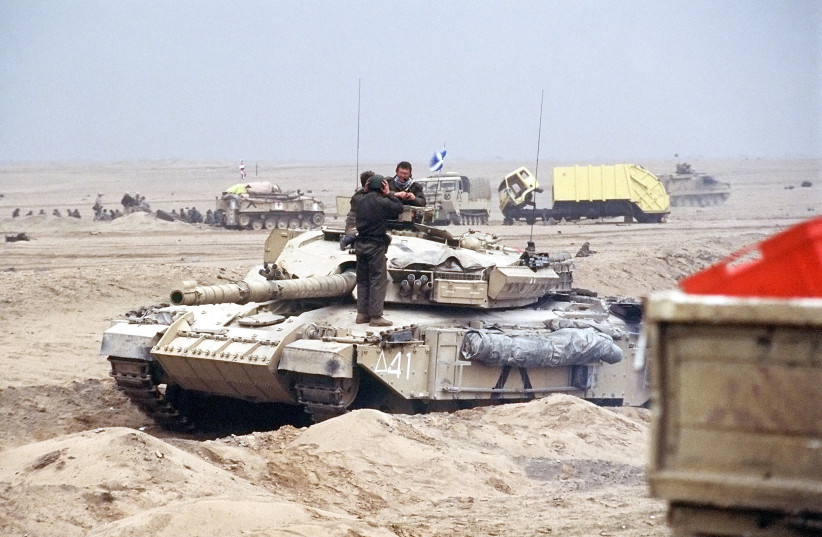The nerve gas sarin and a weak variant of a gene that allows bodies to break down the gas were largely responsible for the syndrome known as Gulf War illness (GWI) which caused a variety of chronic and unexplained symptoms among veterans of the war, scientists at UT Southwestern medical center have found.
Sarin gas is a toxic man-made nerve agent which has been used in chemical warfare and was banned for production in 1997. The agent enters the victim's body through the skin or airways and attacks the nervous system. High levels of exposure often result in death, but lower-level exposure can lead to long-term impairment of brain function.
Sarin, among other chemical agents, was detected in Iraq during the Gulf War, including in a large debris cloud rising from a chemical weapons storage site bombed by the US-led coalition which transited over US ground troop positions.
In a study published in the peer-reviewed journal Environmental Health Perspectives on Wednesday, the scientists explained how they found that veterans exposed to sarin were more likely to develop GWI and that this risk was affected by a gene known as PON1 that usually allows some people's bodies to better break down the nerve gas.
Haley and his team studied 508 deployed veterans who suffered from GWI and 508 deployed veterans who did not develop GWI symptoms.

Gulf War veterans who had a weak variant of the PON1 gene and were exposed to sarin were found to be more likely to develop symptoms of GWI compared to veterans who were exposed and had a stronger variant of the gene.
The PON1 gene has two versions: the Q variant that generates a blood enzyme that efficiently breaks down sarin and the R variant that helps the body break down other chemicals, but not sarin. Everyone carries two copies of the gene and either has a QQ, RR or QR genotype.
Veterans with the QQ genotype who were exposed to sarin had their chances of developing GWI increase by 3.75 times, while those with the QR genotype had their chances increase by 4.43 times and those with the RR genotype had their chances increase by 8.91 times.
Soldiers with both the RR genotype and low-level sarin exposure were over seven times more likely to get GWI, much higher than the increase in risk from both risk factors acting alone, according to the study.
The team added that the study doesn't rule out that other chemical exposures could be responsible for a small number of cases of GWI, although the team was unable to find any other factors that could be contributing causes.
Haley's team is working on further research on how GWI impacts the body and whether any of its effects are reversible.
“Quite simply, our findings prove that Gulf War illness was caused by sarin, which was released when we bombed Iraqi chemical weapons storage and production facilities,” said Dr. Robert Haley, the leader of the research team and professor of Internal Medicine and director of the Division of Epidemiology at UT Southwestern, in a press statement. “There are still more than 100,000 Gulf War veterans who are not getting help for this illness and our hope is that these findings will accelerate the search for better treatment.”
About 700,000 US military personnel and 300,000 people from 41 Coalition countries took part in the 1991 Persian Gulf War.
For months after deployment, tens of thousands of previously fit personnel developed a set of symptoms referred to as GWI, including fatigue, memory and concentration impairment, difficulty finding words, insomnia, diarrhea, constipation, tingling sensations, numbness, balance disturbance, vertigo, and severe pain, among other symptoms.
A number of possible causes have been considered in the past for GWI, including stress, vaccinations, burning oil wells, exposure to pesticides, nerve gas, anti-nerve gas medication, and depleted uranium. While statistical associations have been identified with several of these, none of these have been widely accepted as the underlying cause.
Haley stated that "As far back as 1995, when we first defined Gulf War illness, the evidence was pointing toward nerve agent exposure, but it has taken many years to build an irrefutable case."
While past studies that have linked GWI to sarin exposure have been dismissed due to concerns of recall bias, as veterans may have been more likely to remember and report exposure due to their assumption that it may be linked to GWI, the new study links the illness to a gene-environment interaction "that cannot be explained away by errors in recalling the environmental exposure or other biases in the data," Haley said.
